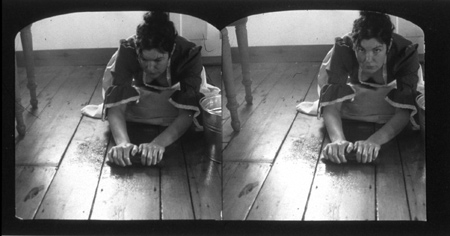会员

级别: 初中二年级
精华: 1
积分: 2496
发帖数: 2349
注册日期: 2006-01
来自: 美国, California, Palo Alto

|
十九世纪渔妇(例一) by Jennifer Crane
试译其中精彩评论:“...画意十足的照片与渔妇的现代意义相悖:一个在大庭广众下,泼辣,粗声粗气,举止不合体的女人......这一系列图景不仅发掘了公共场所,而且还表现了妇女是如何以旁观者和被观察的对象占据公共场所。”
That echo of Victorian exotica surfaces in Jennifer Crane’s series, Seafarers and Fishwives, as well, which in part comprises twenty-four stereo cards seen in 3-D through an antique stereographic viewer. In the late nineteenth century, the middleclass collected these paired photographs of exotic places and people. However,while Crane’s interpretations have an aged, authentic look, the images are strangely subversive: a woman lies on the floor, scrubbing the wood planks; the image nextto it is almost identical, but now she looks up, into the camera, aware of the lens. In another pairing, a fisherman pulls a body from the water while a woman searches the rolling terrain at the water’sedge. Partly inspired by folksongs commemorat-ing women who dressed as men to go to sea, the stereo cards loosely recount such ballads as“The Female Sailor Bold,” about a woman whofollowed her lover across the ocean disguised as a cabin boy: With pitch and tar her hands were hard, tho’ once like velvet soft; She weighed the anchor, heav’d the lead and boldly went aloft. A Nova Scotian herself, Crane heard the term“fishwife” while living in Newfoundland, and re-called the mid-nineteenth century work of David Octavius Hill and Robert Adamson, The Newhaven Fishwives. These grace-ful, painterly photographs clash with the more modern meaning of fishwife— a coarse-mannered, noisy woman who behaves inappropriately in pub-lic. The two taken together have prompted Crane’s own response: a seriesof images that explores not only public space, but how women occupy publicspace as both observers and as the subjects being observed. Thus, both the seafarers and fishwives she portrays are women, most often Crane herself. Among the twenty-four portraits that make up the cartes-de-visite element of the work (again drawing upon a nineteenth-cen-tury phenomenon), Crane can be found in cape and frock, holding a basketof dead fish; or in sailor’s garb, arms crossed like Popeye. The work is in part a playful reference to Crane’s own maritime heritage, and she shot most of it while living in a fishing village in Nova Scotia. Tourists would sometimes photograph her house, never suspecting that a photographer lived inside it, spending her days making artificial self-portraits. At times she found the oglers intrusive, “and then at times I understood their desire to capture an authentic image” — however inauthentic it may have been. Crane’s own photographs, after all, are an ongoing study of class, portraiture, and authenticity. The red velvet lining in the box that holds the stereo cards stands out ina room full of black, white, and grey. The idea that you can reach in, pull outa card, and inspect it through a contraption from a bygone time is just part ofthis exhibition’s playful allure. Doleatto writes that as a child her reality wastransformed by making-believe that everything was not as it seemed, andthat same current of uncertainty, or possibility, runs through both women’swork, which asks only that we observe, and simply absorb what we see.The man who is a woman standing in front of a ship in one of Crane’s stereocards poses seriously at first; then, in the paired image, she almost smirks— she lifts her hand as if acknowledging the boat behind her, and us too, for having seen through her disguise。
虫虎 上传了这个图片:

____________________
艺术=吃饱了撑了打的第一个响嗝(1991)
Art=Communication(1997)
艺术回归大众=大道无形(2005)
|